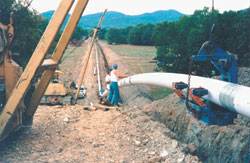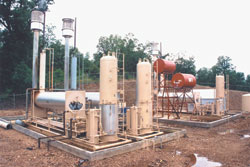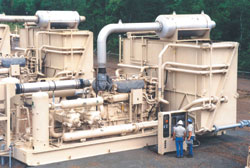|
Oct.
2001 Vol. 222 No. 10
Feature Article
|
NATURAL GAS:
PART 7: COMPRESSION
Cooperative effort allows efficient, fast-track development of a gas field
An operator, its gas marketer and equipment
supplier use ready-to-ship compressor packages and other equipment from inventory to bring the field to full
production
Bill Bowers, The Hanover Company, Houston
 otato
Hills field in southeastern Oklahoma offers an innovative example of how natural gas can be brought to market
efficiently through the cooperative efforts of an exploration and production company, the gathering system’s
operating and construction firm, and the process equipment and services company. Each entity, by focusing on
its core competencies and maintaining an open, clear line of communication with the other companies involved
in the project, maximized its contribution to the project’s success. otato
Hills field in southeastern Oklahoma offers an innovative example of how natural gas can be brought to market
efficiently through the cooperative efforts of an exploration and production company, the gathering system’s
operating and construction firm, and the process equipment and services company. Each entity, by focusing on
its core competencies and maintaining an open, clear line of communication with the other companies involved
in the project, maximized its contribution to the project’s success.
Company Profiles
The GHK Co. is a privately held natural gas exploration
and production company based in Oklahoma City. It was founded in 1959 by Robert A. Hefner III and two other
partners who are no longer associated with the company. GHK’s major E&P activities have been in the
Anadarko basin of western Oklahoma and the Texas Panhandle, the Arkoma-Ouachita fold-and-thrust province of
eastern Oklahoma and the Eastern Cordillera fold-and-thrust belt of Colombia. From its inception through the
mid 1980s, the company was best known for pioneering the deep, high-pressure gas development in the Anadarko
basin, where the company led the industry in technological innovation to successfully drill and produce
several of the world’s deepest, highest-pressure, natural gas wells. In the 1990s, GHK refocused its
future on fold-and-thrust belts, with operations in Colombia and the Arkoma-Ouachita province of eastern
Oklahoma.
Based in Tulsa, Oklahoma, Oneok, Inc., is a diversified
energy corporation, with an assets stronghold that lies across the prolific Mid-Continent. The company is
among the top 10 operators nationally for NGL production. Its marketing efforts reach more than 28 states,
with key interests in the retail natural gas markets of Oklahoma and Kansas. Subsidiaries Oneok Gas
Transportation and Oneok Producer Services offer gas gathering, transportation and producer services to assist
in getting gas from field to market.
Based in Houston, The Hanover Co. specializes in
full-service natural gas compression, and is a provider of service, financing, fabrication and equipment for
contract natural gas handling applications. Hanover provides this equipment on a rental, contract compression
and acquisition leaseback basis to natural gas production, gathering, processing and transportation companies.
Founded in 1990, and a public company since 1997, Hanover’s customers include independent and major
producers and distributors throughout the world.
Project Overview
GHK discovered, developed and operates Potato Hills
field. Oneok constructed and operates the gas-gathering system, and markets the gas for GHK. Hanover
manufactured, operates and maintains the gas compression and production equipment (under contract to Oneok) as
an outsourcing service.
The Potato Hills discovery well was drilled in 1997.
The Ratcliff 1-33 was drilled to a 12,597-ft TD, but was completed in the Jackfork formation at about 5,400
ft. Initial production was delayed until September 1998, when the gas gathering system was completed. The well
initially produced in excess of 10 MMscfd.
Based upon the discovery well’s success, GHK
contracted Oneok to construct a pipeline (Fig. 1) connecting the field gathering system to the ONG Pipeline.
Construction of the original gathering system – which included 7 mi of 12-in. pipeline, dehydration and
sales meter facilities – began in 1998 and was completed later that year. Most of this construction
occurred in mountainous, rocky areas.
 |
|
Fig. 1. A 7-mi, 12-in. pipeline was
constructed to connect Potato Hills field to the gas sales line. Construction, most of which occurred
in mountainous, rocky areas, began in 1998 and was completed later that year. The gathering system was
later expanded to include 7 mi of 20-in. line paralleling (looping) the original 12-in. |
|
While production from Ratcliff 1-33 was being
established, GHK and Oneok contacted Hanover for dehydration equipment. This was to be a temporary
installation until final production rates and pressures could be determined, so Hanover leased a wellhead-type
dehydrator to Oneok.
Since the discovery well’s completion, GHK has
drilled 32 additional wells, of which 23 are currently producing, with another four awaiting completion. The
gathering system has grown to more than 29 mi of pipeline. During the same time period, the processing and
compression facilities have been expanded to handle production rates to 175 MMscfd.
Gas Gathering / Conditioning
To handle radically increased production rates, the
gathering system was expanded to include 7 mi of 20-in. line paralleling (looping) the original 12-in. line
that connects the field to the compression site. Field flowlines include an additional 6 mi of 12-in., 3 mi of
16-in., 4 mi of 8-in. and 2 mi of 6-in. pipeline.
While the compressors were being installed, Hanover
furnished and installed the gas dehydration equipment at a nearby site. Supplied from the company’s
rental fleet, the gas dehydration equipment consisted of a 60-in. ID x 30-ft s/s 1,440-psig absorber-scrubber
with eight trays, and a 750,000-Btu/hr glycol regenerator with pumps, Fig. 2. A horizontal coalescing
filter-separator (48-in. OD x 20-ft s/s 1,440-psig) was later added to eliminate lube oil carry-over from the
compressors to the dehydration station.
 |
|
Fig. 2. Initial gas dehydration
equipment, supplied from the vendor’s rental fleet, included a 60-in. ID x 30-ft s/s 1,440-psig
absorber-scrubber with eight trays, and a 750,000-Btu/hr glycol regenerator with pumps. |
|
As production rates increased, a second dehydrator was
installed. Later, a third unit for future expansion and backup to the existing units was added. Finally, a
scrubber was installed downstream of the dehydrators to catch any glycol carry-over due to upsets.
Hanover also operates and maintains the dehydration and
production equipment, relieving Oneok of the manpower and overhead for these functions and ensuring maximum
up-time for the equipment.
Compression
Potato Hills gas is sweet and lean, and requires no
treatment other than condensed liquid removal prior to compression. Gas from the field gathering system is
piped to an inlet scrubber, consisting of a 60-in. ID x 10-ft s/s 1,440-psig vertical separator with vane mist
extractor. A second, identical scrubber, like the one for the Latimer County wells, was added to handle
additional gas from the Pushmataha wells.
Production from the field peaked at about 145 MMscfd in
early 2001. Typical wellhead pressures range from 450 psig to 550 psig, depending upon the distance between
the wellhead and the compressor station. Inlet (suction) pressure to the compressors is about 400 psig, and
compressor discharge (sales line) pressure is typically 850 psig.
The first compressor was installed at Potato Hills in
November 1999. Between that time and January 2001, six additional compressors were installed to keep up with
increasing gas volumes flowing to the compressor stations, Fig. 3. The primary criterion for selecting the
compressors was to ensure long-term flexibility by designing in the ability to fully use the units’
horsepower over a wide range of suction pressures. The first two compressor packages were single-stage units
shipped from the company’s PDQ fleet in Houston, with the subsequent five units being configured to
operate in one- or two-stage compression service.
 |
|
Fig. 3. The first two compressor
packages included Cat 3516 TALE (1,265-hp) engines with Ariel JGE4-1 single-stage compressors. Five
subsequent units comprised Cat 3606 TALE (1,665-hp) engines with Ariel JGD4-2 two-stage compressors.
The five latter units were set up initially as single-stage compressors, but can be switched to
two-stage by merely reversing three blind flange paddles on the skid piping and cooler. |
|
The Hanover PDQ program provides an immediate inventory
of ready-to-ship compressors comprising one-, two- or three-stage standardized units with Ariel compressors
and Caterpillar or Waukesha drivers ranging from 1,000 to 1,665 hp. These units are built on speculation, with
a revolving inventory available for both onshore and offshore applications.
The initial two units selected for this project were
Cat 3516 TALE (1,265-hp) engines with Ariel JGE4-1 single-stage compressors. The five subsequent units were
all Cat 3606 TALE (1,665-hp) engines with Ariel JGD4-2 two-stage compressors. On the last five units, the
cylinder selection, on-skid piping and cooler design were such that the units could be used initially as
single-stage compressors. As field (suction) pressure declines, the units can be switched to a two-stage
configuration by merely reversing three blind flange paddles on the skid piping and cooler.
The first-stage cylinders on these units were
high-pressure PDQ cylinders that provide working pressures high enough to be used in the initial single-stage
service required (850 to 950 psig discharge). Use of these smaller first-stage cylinders, typically found in
offshore two-stage configurations, allowed the higher working pressure needed for single-stage service and a
lower rod load over the entire range of design pressures. This cylinder selection also allows the compressors
to operate fully loaded, as the field draws down and suction pressures decline.
Plant Controls
The dehydration plant and compressors are equipped with
local control panels incorporating safety shutdowns, operator alarms and annunciators for cause of shutdown.
Hanover field operating personnel are typically on site daily, and a backup remote monitoring system is
incorporated in Oneok’s gas control center if a unit goes down after hours. Individual systems will
automatically shut down for safety reasons and to protect the equipment from damage.
Future Plans
Potato Hills field now covers southern Latimer County
and northern Pushmataha County of southeastern Oklahoma. To date, the field has produced more than 80 Bscf.
Most of this production has been from the Jackfork formation.
In the near-future, GHK will continue to develop the
Jackfork formation while also testing other, deeper reservoirs. Seismic data indicate that this subthrusted
anticlinal play could ultimately produce in excess of 3 Tscf, if deeper pay zones are productive.


The author |
 |
Bill Bowers
is a product manager for The Hanover Company, working in the Integrated Systems Group at the Houston
headquarters. He has previously worked for Peak Process, Inc., Conoco Specialty Products, and Vortoil
Separations Systems in various engineering and management roles supporting applications, design and
manufacture of liquids separation processes. Prior to beginning his oilfield career with Schlumberger in
1976, he earned a BS in electrical engineering from the Georgia Institute of Technology. |
| |
|
 |
 |
Part 1:
Exploration Methods |
 |
Part 2: North
America Outlook |
 |
Part 3: HP/HT
Drilling and Completions |
 |
Part 4: Tight
Formation Stimulation |
|
Part 5: Sour
Gas Handling |
 |
Part 6:
Anomalously pressured zones |
 |
Part 8:
Monetizing Stranded Gas |
|






